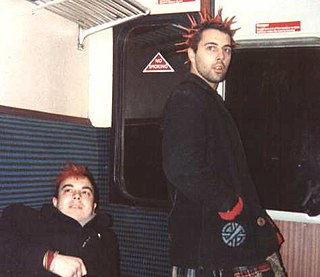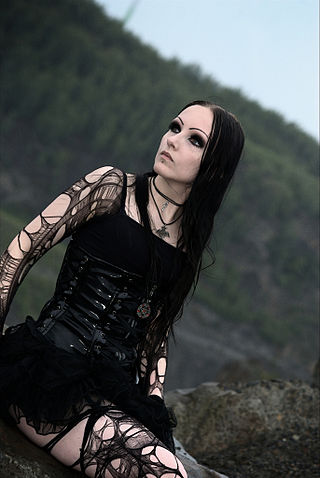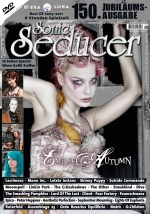
Goth is a music-based subculture that began in the United Kingdom during the early 1980s. It was developed by fans of gothic rock, an offshoot of the post-punk music genre. Post-punk artists who presaged the gothic rock genre and helped develop and shape the subculture include Siouxsie and the Banshees, Bauhaus, the Cure, and Joy Division.
Gothic rock is a style of rock music that emerged from post-punk in the United Kingdom in the late 1970s. The first post-punk bands which shifted toward dark music with gothic overtones include Siouxsie and the Banshees, Joy Division, Bauhaus, and the Cure.

Gothic fashion is a clothing style marked by dark, mysterious, antiquated, homogeneous, and often genderless features. It is worn by members of the goth subculture. Typical gothic fashion includes dyed black hair, exotic hairstyles, dark lipstick and dark clothing. Both male and female goths can wear dark eyeliner, dark nail polish and lipstick for a dramatic effect. Male goths use cosmetics at a higher rate than other men. Styles are often borrowed from the punk fashion and can also draw influence from Victorians and Elizabethan fashion. Goth fashion is sometimes confused with heavy metal fashion and emo fashion.

Punk fashion is the clothing, hairstyles, cosmetics, jewellery, and body modifications of the punk counterculture. Punk fashion varies widely, ranging from Vivienne Westwood designs to styles modeled on bands like The Exploited to the dressed-down look of North American hardcore. The distinct social dress of other subcultures and art movements, including glam rock, skinheads, greasers, and mods have influenced punk fashion. Punk fashion has likewise influenced the styles of these groups, as well as those of popular culture. Many punks use clothing as a way of making a statement.
Dark wave is a music genre that emerged from the new wave and post-punk movement of the late 1970s. Dark wave compositions are largely based on minor key tonality and introspective lyrics and have been perceived as being dark, romantic and bleak, with an undertone of sorrow. The genre embraces a range of styles including cold wave, ethereal wave, gothic rock, neoclassical dark wave and neofolk.
A rivethead or rivet head is a person associated with the industrial dance music scene. In stark contrast to the original industrial culture, whose performers and heterogeneous audience were sometimes referred to as "industrialists", the rivethead scene is a coherent youth culture closely linked to a discernible fashion style. The scene emerged in the late 1980s on the basis of electro-industrial, EBM, and industrial rock music. The associated dress style draws on military fashion and punk aesthetics with hints of fetish wear, mainly inspired by the scene's musical protagonists.

Bondage pants or bondage trousers are trousers with zippers, straps, chains, rings and buckles, giving an appearance of a BDSM style. They come in a variety of colors and patterns; one of the most common patterns being tartan. Bondage pants also come in a variety of styles, including tight or baggy, long, short or Capri.

Fashion in the 1990s was defined by a return to minimalist fashion, in contrast to the more elaborate and flashy trends of the 1980s. One notable shift was the mainstream adoption of tattoos, body piercings aside from ear piercing and, to a much lesser extent, other forms of body modification such as branding.
Japanese street fashion refers to a number of styles of contemporary modern clothing in Japan. Created from a mix of both local and foreign fashion brands, Japanese street fashions tend to have their own distinctive style, with some considered to be extreme and avant-garde, with similarities to the haute couture styles seen on European catwalks.

Dark culture, also called dark alternative scene, includes goth and dark wave culture, the dark neoclassical/dark ambient scene, parts of the post-industrial scene parts of neofolk and the early gothic metal scene. Dark culture's origin lies in followers of dark wave and independent music, but over the decades it has developed to a social network held together by a common concept of aesthetics, self-representation, and individualism. The musical preferences of the dark scene are characterized by a mix of styles ranging from futurism, electropop, early music, (neo-) classical, and folk music to punk rock, rock, techno and ambient music.

The fashion of the 2000's is often described as a global mash up, where trends saw the fusion of vintage styles, global and ethnic clothing, as well as the fashions of numerous music-based subcultures. Hip-hop fashion generally was the most popular among young people of all sexes, followed by the retro inspired indie look later in the decade.
Alternative fashion or alt fashion is fashion that stands apart from mainstream, commercial fashion. It includes both styles which do not conform to the mainstream fashion of their time and the styles of specific subcultures. Some alternative fashion styles are attention-grabbing and more artistic than practical, while some develop from anti-fashion sentiments that focus on simplicity and utilitarianism.
The Toronto goth scene, the cultural locus of the goth subculture in Toronto, Ontario, Canada and the associated music and fashion scene, has distinct origins from goth scenes of other goth subcultural centres, such as the UK or Germany. Originally known as the "Batcavers", the term "goth" appeared only after 1988, when it was applied to the pre-existent subculture. Distinctive features included internationally recognized gothic and vampiric fashion store 'Siren', a goth-industrial bar named 'Sanctuary: The Vampire Sex Bar', and Forever Knight, a television series about an 800-year-old vampire living in Toronto. In Toronto, the goths did not seek to reject mainstream status, and achieved partial acceptance throughout the mid to late 1990s.
Bats Day in the Fun Park, also known as Bats Day, Goth Day, Goth Day at Disneyland, The Spooky Trip to Disneyland Resort, CA., Bats Day in the Park and Bats Day Out, started in August 1999 as a joint effort between the promoters of the goth, industrial, and deathrock clubs Absynthe and Release the Bats. It has become an annual three-day event taking place in Anaheim, CA, United States near Disneyland. In previous years, the events commenced on the weekend before Labor Day. Since about 2008, Bats Day event weekends have usually happened on the first or third weekend in May.
VampireFreaks.com is an online clothing store and former social networking site for goths and rivetheads. VampireFreaks was launched as a social networking site in 1999 and added an online clothing store in 2001. The social network element was removed in February 2020.

Synthetic dreads, also called dread extensions, dread falls, and cyberlocks, are interlocked coils of synthetic hair, mostly kanekalon, that give the look and feel of natural dreadlocks without the commitment or maintenance. They are mainly worn as a fashion statement for the subculture of cybergoth.
Futurepop is an electronic music genre that has been characterized as a blend of synthpop, EBM and dance beats, based on trance and techno.

Sonic Seducer is a German music magazine that covers gothic rock, new wave, EBM and other kinds of electronic music and culture. The magazine is noted for organizing the annual M'era Luna Festival. Since its inception in 1994, the Sonic Seducer has become one of the major publications of the dark culture in Germany.

Mall goths are a subculture that began in the late-1990s in the United States. Originating as a pejorative to describe people who dressed goth for the fashion rather than culture, it eventually developed its own culture based around nu metal, industrial metal, emo and the Hot Topic store chain. It has variously been described as a part of the goth subculture, as well as a separate subculture simply influenced by goth.












